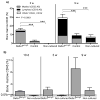Notch-mediated expansion of human cord blood progenitor cells capable of rapid myeloid reconstitution
- PMID: 20081862
- PMCID: PMC2819359
- DOI: 10.1038/nm.2080
Notch-mediated expansion of human cord blood progenitor cells capable of rapid myeloid reconstitution
Abstract
Delayed myeloid engraftment after cord blood transplantation (CBT) is thought to result from inadequate numbers of progenitor cells in the graft and is associated with increased early transplant-related morbidity and mortality. New culture strategies that increase the number of cord blood progenitors capable of rapid myeloid engraftment after CBT would allow more widespread use of this stem cell source for transplantation. Here we report the development of a clinically relevant Notch-mediated ex vivo expansion system for human CD34(+) cord blood progenitors that results in a marked increase in the absolute number of stem/progenitor cells, including those capable of enhanced repopulation in the marrow of immunodeficient nonobese diabetic-severe combined immunodeficient (NOD-SCID) mice. Furthermore, when cord blood progenitors expanded ex vivo in the presence of Notch ligand were infused in a clinical setting after a myeloablative preparative regimen for stem cell transplantation, the time to neutrophil recovery was substantially shortened. To our knowledge, this is the first instance of rapid engraftment derived from ex vivo expanded stem/progenitor cells in humans.
Conflict of interest statement
Figures



Comment in
-
Notch signaling: from stem cell expansion to improving cord blood transplantation.Expert Rev Hematol. 2010 Aug;3(4):401-4. doi: 10.1586/ehm.10.37. Expert Rev Hematol. 2010. PMID: 21083031
Similar articles
-
Delayed engraftment of nonobese diabetic/severe combined immunodeficient mice transplanted with ex vivo-expanded human CD34(+) cord blood cells.Blood. 1999 Feb 1;93(3):1097-105. Blood. 1999. PMID: 9920860
-
Preclinical ex vivo expansion of cord blood hematopoietic stem and progenitor cells: duration of culture; the media, serum supplements, and growth factors used; and engraftment in NOD/SCID mice.Transfusion. 2001 Dec;41(12):1567-76. doi: 10.1046/j.1537-2995.2001.41121567.x. Transfusion. 2001. PMID: 11778074
-
Co-culture of cord blood CD34(+) cells with human BM mesenchymal stromal cells enhances short-term engraftment of cord blood cells in NOD/SCID mice.Cytotherapy. 2007;9(4):338-47. doi: 10.1080/14653240701291638. Cytotherapy. 2007. PMID: 17573609
-
Endothelium-targeted human Delta-like 1 enhances the regeneration and homing of human cord blood stem and progenitor cells.J Transl Med. 2016 Jan 6;14:5. doi: 10.1186/s12967-015-0761-0. J Transl Med. 2016. PMID: 26740017 Free PMC article.
-
Ex vivo expansion and engraftment potential of cord blood-derived CD34+ cells in NOD/SCID mice.Ann N Y Acad Sci. 2001 Jun;938:9-17. doi: 10.1111/j.1749-6632.2001.tb03569.x. Ann N Y Acad Sci. 2001. PMID: 11458530 Review.
Cited by
-
Increasing hematopoietic stem cell yield to develop mice with human immune systems.Biomed Res Int. 2013;2013:740892. doi: 10.1155/2013/740892. Epub 2013 Feb 14. Biomed Res Int. 2013. PMID: 23509770 Free PMC article. Review.
-
Treosulfan-based conditioning is feasible and effective for cord blood recipients: a phase 2 multicenter study.Blood Adv. 2020 Jul 28;4(14):3302-3310. doi: 10.1182/bloodadvances.2020002222. Blood Adv. 2020. PMID: 32706891 Free PMC article. Clinical Trial.
-
Pharmacological inhibition of AKT activity in human CD34+ cells enhances their ability to engraft immunodeficient mice.Exp Hematol. 2017 Jan;45:74-84. doi: 10.1016/j.exphem.2016.09.003. Epub 2016 Sep 17. Exp Hematol. 2017. PMID: 27645691 Free PMC article.
-
Emerging concepts in haematopoietic cell transplantation.Nat Rev Immunol. 2012 May 25;12(6):403-16. doi: 10.1038/nri3226. Nat Rev Immunol. 2012. PMID: 22627859 Free PMC article. Review.
-
Expansion on stromal cells preserves the undifferentiated state of human hematopoietic stem cells despite compromised reconstitution ability.PLoS One. 2013;8(1):e53912. doi: 10.1371/journal.pone.0053912. Epub 2013 Jan 16. PLoS One. 2013. PMID: 23342037 Free PMC article.
References
-
- Shpall E, et al. Transplantation of Ex Vivo Expanded Cord Blood. Biology of Blood and Marrow Transplantation. 2002;8:368–376. - PubMed
-
- Jaroscak J, et al. Augmentation of umbilical cord blood (UCB) transplantation with ex vivo-expanded UCB cells: results of a phase 1 trial using the AastromReplicell System. Blood. 2003;101:5061–7. - PubMed
-
- Milner LA, Kopan R, Martin DI, Bernstein ID. A human homologue of the Drosophila developmental gene, Notch, is expressed in CD34+ hematopoietic precursors. Blood. 1994;83:2057–62. - PubMed
-
- Varnum-Finney B, et al. Pluripotent, cytokine-dependent, hematopoietic stem cells are immortalized by constitutive Notch1 signaling. Nat Med. 2000;6:1278–81. - PubMed
Publication types
MeSH terms
Substances
Grants and funding
LinkOut - more resources
Full Text Sources
Other Literature Sources
Medical

